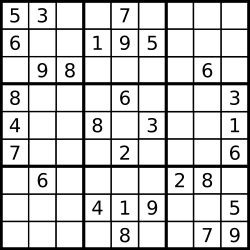Write a program to solve a Sudoku puzzle by filling the empty cells.
Empty cells are indicated by the character ‘.‘.
You may assume that there will be only one unique solution.

A sudoku puzzle...

...and its solution numbers marked in red.
解数独
class Solution {
public:
bool isValid(vector<vector<char> > &board, int i, int j){
//判断所在行
for(int col=0; col<9; col++){
if(col!=j && board[i][j]==board[i][col])return false;
}
//判断所在列
for(int row=0; row<9; row++){
if(row!=i && board[i][j]==board[row][j])return false;
}
//判断所在block
int x=i/3*3;
int y=j/3*3;
for(int row=x; row<x+3; row++){
for(int col=y; col<y+3; col++){
if(row!=i && col!=j && board[i][j]==board[row][col])return false;
}
}
return true;
}
bool sodoku(vector<vector<char> > &board){
for(int i=0; i<9; i++){
for(int j=0; j<9; j++){
if(board[i][j]==‘.‘){
for(int value=1; value<=9; value++){
board[i][j]=‘0‘+value;
if(isValid(board, i, j)&&sodoku(board))return true;
board[i][j]=‘.‘;
}
return false;
}
}
}
return true;
}
void solveSudoku(vector<vector<char> > &board) {
sodoku(board);
}
};LeetCode: Sudoku Solver [036],布布扣,bubuko.com
原文地址:http://blog.csdn.net/harryhuang1990/article/details/26288697